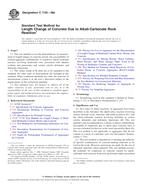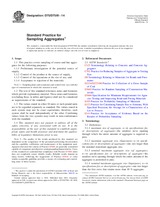We need your consent to use the individual data so that you can see information about your interests, among other things. Click "OK" to give your consent.
ASTM C1105-08a
Standard Test Method for Length Change of Concrete Due to Alkali-Carbonate Rock Reaction (Includes all amendments And changes 12/23/2016).
Automatically translated name:
Standard Test Method for Length Change of Concrete Due to Alkali-Carbonate Rock Reaction
STANDARD published on 1.12.2008
The information about the standard:
Designation standards: ASTM C1105-08a
Note: WITHDRAWN
Publication date standards: 1.12.2008
SKU: NS-9523
The number of pages: 4
Approximate weight : 12 g (0.03 lbs)
Country: American technical standard
Category: Technical standards ASTM
The category - similar standards:
Annotation of standard text ASTM C1105-08a :
Keywords:
Alkali reactivity, Calcitic dolomites, Carbonate aggregates, Cement-aggregate combinations, Change in length, Coarse aggregate, Concrete--specifications, Dolomitic limestone, Expansion--concrete materials/applications, Lime materials/applications, ICS Number Code 91.100.30 (Concrete and concrete products)
Additional information
| Significance and Use | ||||||||||||||||||||||||||||
|
Two types of alkali reactivity of aggregates have been described in the literature: the alkali-silica reaction involving certain siliceous rocks, minerals, and artificial glasses (1), and the alkali-carbonate reaction involving dolomite in certain calcitic dolomites and dolomitic limestones (2). This test method is not recommended as a means to detect combinations susceptible to expansion due to alkali-silica reaction since it was not evaluated for this use in the work reported by Buck (2). This test method is not applicable to aggregates that do not contain or consist of carbonate rock (see Descriptive Nomenclature C 294). This test method is intended for evaluating the behavior of specific combinations of concrete-making materials to be used in the work. However, provisions are made for the use of substitute materials when required. This test method assesses the potential for expansion of concrete caused by alkali-carbonate rock reaction from tests performed under prescribed laboratory curing conditions that will probably differ from field conditions. Thus, actual field performance will not be duplicated due to differences in wetting and drying, temperature, other factors, or combinations of these (see Appendix X1). Use of this test method is of particular value when samples of aggregate from a source have been determined to contain constituents that are regarded as capable of participation in a potentially deleterious alkali-carbonate rock reaction either by petrographic examination, Guide C 295, by the rock cylinder test, Test Method C 586, by service record; or by a combination of these. Results of tests conducted as described herein should form a part of the basis for a decision as to whether precautions be taken against excessive expansion due to alkali-carbonate rock reaction. This decision should be made before a particular cement-aggregate combination is used in concrete construction (see Note 1). Note 1—Other elements that may be included in the decision-making process for categorizing an aggregate or a cement-aggregate combination with respect to whether precautions are needed, and examples of precautions that may be taken, are described in Appendix X1. While the basic intent of this test method is to develop information on a particular cement-aggregate combination, it will usually be very useful to conduct control tests in parallel using the aggregate of interest with other cements or the cement of interest with other aggregates. |
||||||||||||||||||||||||||||
| 1. Scope | ||||||||||||||||||||||||||||
|
1.1 This test method covers the determination, by measurement of length change of concrete prisms, the susceptibility of cement-aggregate combinations to expansive alkali-carbonate reaction involving hydroxide ions associated with alkalies (sodium and potassium) and certain calcitic dolomites and dolomitic limestones. 1.2 The values stated in SI units are to be regarded as the standard. No other units of measurement are included in this standard. When combined standards are cited, the selection of measurement system is at the user's discretion subject to the requirements of the referenced standard. 1.3 This standard does not purport to address all of the safety concerns, if any, associated with its use. It is the responsibility of the user of this standard to establish appropriate safety and health practices and determine the applicability of regulatory limitations prior to use. |
||||||||||||||||||||||||||||
| 2. Referenced Documents | ||||||||||||||||||||||||||||
|
Similar standards:
Historical
1.8.2008
Historical
1.8.2008
Historical
1.2.2008
Historical
1.6.2014
Historical
1.6.2010
Historical
1.7.2011
We recommend:
Updating of laws
Do you want to be sure about the validity of used regulations?
We offer you a solution so that you could use valid and updated legislative regulations.
Would you like to get more information? Look at this page.



 ASTM D7276-08
ASTM D7276-08 ASTM D7277-08
ASTM D7277-08 ASTM D7428-08e1
ASTM D7428-08e1 ASTM D75/D75M-14..
ASTM D75/D75M-14.. ASTM D7508/D7508M-10..
ASTM D7508/D7508M-10.. ASTM D994/D994M-11..
ASTM D994/D994M-11..
 Cookies
Cookies
